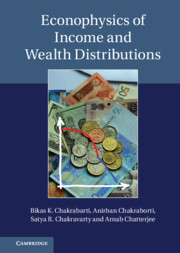Book contents
- Frontmatter
- Contents
- Preface
- 1 Introduction
- 2 Income and wealth distribution data for different countries
- 3 Major socioeconomic modelling
- 4 Market exchanges and scattering process
- 5 Analytic structure of the kinetic exchange market models
- 6 Microeconomic foundation of the kinetic exchange models
- 7 Dynamics: generation of income, inequality and development
- 8 Outlook
- References
- Index
7 - Dynamics: generation of income, inequality and development
Published online by Cambridge University Press: 05 May 2013
- Frontmatter
- Contents
- Preface
- 1 Introduction
- 2 Income and wealth distribution data for different countries
- 3 Major socioeconomic modelling
- 4 Market exchanges and scattering process
- 5 Analytic structure of the kinetic exchange market models
- 6 Microeconomic foundation of the kinetic exchange models
- 7 Dynamics: generation of income, inequality and development
- 8 Outlook
- References
- Index
Summary
In some of the earlier chapters, we have presented in detail the models which have been inspired from physical theories. In the last chapter, we presented a simple economic model which intends to capture the basic features of the kinetic exchange models. The objective of this chapter is to present analytical discussions on stochastic and related economic models of the distribution of income and wealth.
The economic significance
In order to get an idea about the distributional effects of a particular economic policy it often becomes necessary to have information on the distribution of income. Also inequality based on distribution of income has important effects on development, social outcomes and public finance. The shape of the income distribution in a country enables the policy-makers to get an idea about the amount of tax collection. For instance, in Germany 50.6% (19.7%) of the entire income tax is paid by the top 10% (1%) of the taxpayers (see Merz et al. 2005).
There are economic and non-economic reasons for separate study of the distribution of wealth that cannot be interpreted as human capital, such as educational background. Examples of wealth of this type are financial assets and real properties. Unlike human capital they can be traded in appropriate markets at the time of necessity; for instance, when the flow of regular income reduces (after retirement) and when consumption is likely to increase with an increase in family size. Precautionary motive for saving is also regarded as a major reason for accumulation of wealth. Wealth accumulation is often taken as an indicator of social status. Wealth may be retained as well for the purpose of bequests.
- Type
- Chapter
- Information
- Econophysics of Income and Wealth Distributions , pp. 168 - 192Publisher: Cambridge University PressPrint publication year: 2013



